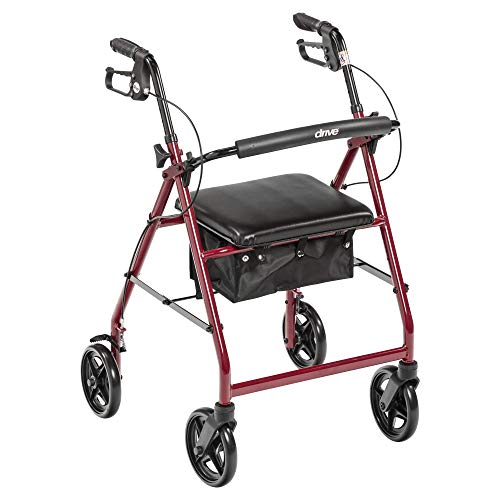Discussion Board
About Me
Rollator Mobility Walker
Rollators are a great choice for those with limitations in mobility and require stability while walking. They come with large wheels and spaces built into the frame for seating.
 This model features padded handles to provide the user with comfort and reduce pressure on their hands. It has height-adjustable handlebars and intuitive loop locks that prevent the walker from moving even when you're resting or sitting.
This model features padded handles to provide the user with comfort and reduce pressure on their hands. It has height-adjustable handlebars and intuitive loop locks that prevent the walker from moving even when you're resting or sitting.
Comfort
Whether someone has recently suffered an injury that affects their gait and balance or recovering from knee, hip, or other lower-limb surgeries, or injuries, a rollator mobility walker can aid. These walking aids provide stability and support that allows users to walk with greater ease while keeping them active and engaged with their family, friends and community.
They come in a variety of forms, including a traditional walker, which has no wheels and is simpler than rolling. Walkers typically have handles that are set at a height that is most comfortable for the user, which makes them ideal for those who requires a stable support, but would like to be able move forward more easily than with a cane.
However, the wheels on a rollator make it more flexible than a normal walker and more user-friendly. The wheels on a rollator are more together so that it is easier to move and control the device when in tight areas. They can also be rotated to increase the speed of going up and down steps. A lot of rollators have a seating area with a crossbar so that users can sit down if they need to.
The handles of a rollator can be made of materials that vary in thickness and texture. Choose handles that have soft texture and soft plastic grip. This is easier to hold for people with arthritis. Be sure to check whether the device comes with loop-lock breaks or brakes that are activated by lean to accommodate various hand sizes.
Stability
A great rollator must have a comfortable and wide seat that users can relax on when they want to take a break. It should also have soft ergonomic grips, brakes that are easy to operate. These grips should be cushioned and suitable for people who have wrist or hand problems. Some models have padded backrest for additional support. It is crucial to choose a walker that has enough capacity for your weight, and one with adjustable handles to fit your height.
A locking mechanism for a walker is crucial for people who travel frequently or need to transport the walker inside and out of their vehicle. It will keep the walker from being accidentally opened during transport, thereby preventing injuries and harm. Another feature to consider is whether the walker comes with removable and interchangeable parts so you can customize it to meet your requirements.
Researchers conducted a study to find out how the task-performance strategy, and the device load affect rollator stability. The study involved ten people who completed six tasks using an instrumented Aluminium Rollator with Seat - Four Wheel MobilityCare. The team measured the total centre of pressure and base of support that is known as the system Stability Margin (SM). They found that SM is reduced significantly when compared to straight line walking to other tasks. They also discovered that leaning on the device may increase the force centre in the base support and increase or decrease stability. The authors conclude that the findings can be utilized to improve the rollator training. They suggest that more emphasis should be put on other activities that are not straight line walking and on specific strategies for each activity that can aid or hinder stability.
Capacity to bear weight
A rollator walker is able to support up to 300 pounds or more, based on the model. Its robust frame and four wheels aid in maintaining balance and mobility, especially for individuals with medical conditions or who are ageing. Rollators are less difficult to maneuver than standard walkers that require the user to lift their weight to move forward. This helps reduce hand fatigue.
The wheels on a rollator generally range in size between 6 and 10 inches in diameter, providing users with the flexibility to use it for indoor and outdoor use on different surfaces. Certain models have a variety of height options for different users. Others fold to make it easy to transport and store. Some models even have a seat that allows the user to rest while walking.
Many walkers include a variety accessories. For instance the walker tray or basket for storing personal items. A wrist guard is offered to protect your hands from injury, as well as bags for walker's to store your other belongings. Some walker frames are compatible with wheelchairs, making them simple to change when one's mobility requirements change.
A bariatric rolling device is designed with a sturdy frame and wider seat to support larger individuals. It has a wide padded seat with adjustable handles and locking hand brakes to ensure maximum safety. The angled bars for the handle keep the hands in a neutral position to prevent stress and fatigue and its handy storage strap makes it easy to fit into a vehicle's trunk. The 8" wheels feature anti-tip technology that provides stability and a greater maneuverability. The seat cushion is an ideal place to relax while on the move.
Brakes
A rollator is different from a standard walker. Instead of having all four legs touch the ground, a rollator has wheels that are controlled by hand brakes situated below or incorporated into the handlebars. This design makes it easier for users to navigate tight spaces and make quick left or right turns. However, the brakes could sometimes become loose or hard to use, which can be a safety issue for those who have declining mobility and limited strength in their hands.
To prevent these issues, a lot of manufacturers allow you to add brakes that can be locked for added security and stability. This feature is particularly beneficial for those who have trouble getting the brakes to squeeze or applying pressure due to a weak grip or other health issues like arthritis. There are some variations in the method that the locking brakes are set however, most walkers follow similar steps to make sure they are set correctly.
It is essential to read the maintenance guidelines that come with your mobility device to get specific directions before attempting to adjust lock brakes. To begin, find the adjustment screw for brakes or knob that is usually close to the grips of the handle. Make sure to tighten it by rotating clockwise. This step is crucial since if you do not tighten the adjuster in the correct way, it won't be possible to get rid of the slack inside the brake cable. Then, tighten the lower cable adjuster by using the same method. After you have made these adjustments, test the brakes by pressing them gently and see whether they respond in a timely manner. If they don't then the locking mechanism is probably not working properly.
Accessories
There are a variety of accessories available for rollator walkers, including cups and baskets. Some are ideal for carrying things while walking and some such as the Mobility Phone Grip, clip onto the bars on the vertical sides of a walker or wheelchair and expand to hold the smartphone. The grips can also swivel and adjust to the ideal height for holding the device. Many of these accessories have been designed to be light, easy to use and ideal for those with arthritis.
Most manufacturers of walker and rollator offer a range of handle heights, so you can select the most suitable one for your body type. Take into consideration the weight capacity when selecting the right rollator. This will affect how well it will work for you. While most rollators are designed to help those who weigh between 300 and 300 pounds, some manufacturers have bariatric versions that can support up to 500 pounds.
When you are choosing a walker or rollator, it is important to be aware of the type of brakes. Push down brakes function by putting downward pressure on the frame to stop forward movement. Loop brakes are similar, however, they require simultaneous use of both hands and more physical strength to apply. Both types of brakes provide essential safety features, so it is crucial to select the one that is right for you.
If you're unsure which type of walker or Ultra Lightweight 3-Wheel Rollator for Mobility - Silver is the right one for you, it's suggested that you talk to your physical therapist, doctor, or occupational therapist. They can advise you about the features that are most beneficial for your specific situation, and can help you find the right model that is compatible with any equipment you may have at home or stored.
Location
Occupation
Latest Post: Kamagra vs Viagra, any experience? Our newest member: kaitlynbest926 Recent Posts Unread Posts Tags
Forum Icons: Forum contains no unread posts Forum contains unread posts
Topic Icons: Not Replied Replied Active Hot Sticky Unapproved Solved Private Closed

